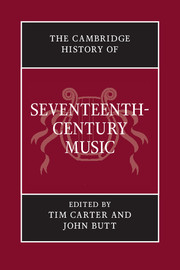Book contents
- Frontmatter
- 1 Renaissance, Mannerism, Baroque
- 2 The seventeenth-century musical ‘work’
- 3 Music in the market-place
- 4 Music in new worlds
- 5 Music and the arts
- 6 Music and the sciences
- 7 The search for musical meaning
- 8 Power and display: music in court theatre
- 9 Mask and illusion: Italian opera after 1637
- 10 The Church Triumphant: music in the liturgy
- 11 Devotion, piety and commemoration: sacred songs and oratorios
- 12 Image and eloquence: secular song
- 13 Fantasy and craft: the solo instrumentalist
- 14 Form and gesture: canzona, sonata and concerto
- Appendix I Chronology
- Appendix II Places and institutions
- Appendix III Personalia
- Index
- References
10 - The Church Triumphant: music in the liturgy
Published online by Cambridge University Press: 28 March 2008
- Frontmatter
- 1 Renaissance, Mannerism, Baroque
- 2 The seventeenth-century musical ‘work’
- 3 Music in the market-place
- 4 Music in new worlds
- 5 Music and the arts
- 6 Music and the sciences
- 7 The search for musical meaning
- 8 Power and display: music in court theatre
- 9 Mask and illusion: Italian opera after 1637
- 10 The Church Triumphant: music in the liturgy
- 11 Devotion, piety and commemoration: sacred songs and oratorios
- 12 Image and eloquence: secular song
- 13 Fantasy and craft: the solo instrumentalist
- 14 Form and gesture: canzona, sonata and concerto
- Appendix I Chronology
- Appendix II Places and institutions
- Appendix III Personalia
- Index
- References
Summary
During the seventeenth century, religious observance played an essential part in people’s lives, both as the consequence of a pervasive system of belief that was seldom questioned, and as the crucial declaration of a confessional allegiance that might also have strong political overtones. Music had an important part to play in the articulation of this allegiance, whether by an aggressive presence, as in a Catholic festal Vespers in southern Europe, or a conspicuous absence, as in Calvinist-inspired preaching services north of the Alps. In most denominations, music was recognised as a powerful if somewhat dangerous weapon, able to attract and sway men’s souls, and thus subject to sometimes considerable ecclesiastical control. As a rhetorical art, it was akin to preaching – indeed it was at times deliberately linked to it: composers were expected not only to ‘read’ sacred texts through their music but also to interpret them for their listeners. On the Catholic side, the new orders, especially the Jesuits and the Oratorians, made explicit use of music for evangelisation. Already in the 1580s, Annibale Stabile, maestro di cappella of the Jesuit-run German College in Rome, could state that he had learnt more about the setting of words from its Jesuit rector, Michele Lauretano, than he had in years of previous musical study (which had included a spell under Palestrina). The German College remained hugely influential, sending priests to all parts of Germany and as far afield as Hungary. Jesuit missionaries were also sent all over Europe and to the New World, bringing with them the advocacy of music, not least in the education of the young and in their targeting of the aristocracy; their preference was for Italian, especially Roman musical styles.
- Type
- Chapter
- Information
- The Cambridge History of Seventeenth-Century Music , pp. 283 - 323Publisher: Cambridge University PressPrint publication year: 2005
References
- 2
- Cited by



